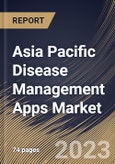The primary factor influencing the market for disease management apps is the increased prevalence of chronic diseases, together with increasing consumer awareness of healthy lifestyles. As a result of certain benefits these apps provide in terms of monitoring and enhancing health, the government and business entities are expected to promote the adoption of disease management apps more and more in the upcoming years. For instance, the CDC mobile app, which was created by the CDC, is a useful tool for managing diseases at home and is compatible with both Android and iOS devices.
Additionally, a growing number of market participants are releasing apps for the management of chronic diseases like heart conditions and diabetes, which is further boosting the market growth. Consumers are embracing smart wearable technology items more and more, which is propelling market expansion. By using sensors, these gadgets help monitor health by proactively keeping track of things like oxygen levels, cholesterol levels, and calories burned. In addition, a number of businesses are releasing wearable electronics accessories, including watches, from Samsung, Noise, Fossil Group, and Fitbit. Customers are expected to be drawn to such a feature because it allows them to assess their health.
East Asia is anticipated to experience the rapid adoption of mental health apps in the coming years due to factors like rising internet penetration and the stress levels of individuals and society. Additionally, the East Asia region includes nations with both developing and advanced economies, like China and Japan. As living standards rise, digital literacy is being used more frequently throughout the Asia Pacific. The prevalence of smart devices has increased as a result, including smartphones, laptops, and tablets. Furthermore, in recent years, especially in emerging nations, there has been a significant surge in the production of AI-based apps. These elements will cause the Asia Pacific region's disease management apps market to expand significantly.
The China market dominated the Asia Pacific Disease Management Apps Market by Country in 2022, and would continue to be a dominant market till 2029; thereby, achieving a market value of $1,438.4 million by 2029. The Japan market is estimated to grow a CAGR of 12.6% during (2023-2029). Additionally, The India market would experience a CAGR of 13.9% during (2023-2029).
Based on Indication, the market is segmented into Obesity, Mental Health, Cardiovascular Issues, Diabetes and Others. Based on Device, the market is segmented into Smartphones, Tablets, and Wearables. Based on Platform Type, the market is segmented into Android, iOS and Others. Based on countries, the market is segmented into China, Japan, India, South Korea, Singapore, Malaysia, and Rest of Asia Pacific.
The market research report covers the analysis of key stake holders of the market. Key companies profiled in the report include Fitbit, Inc. (Google LLC), Sleepcycle AB, Noom, Inc., Medisafe Project Ltd., Azumio, Inc., Healthy.io Ltd., MyFitnessPal, Inc., Curable, Inc., Bearable Ltd and Omada, Health, Inc.
Scope of the Study
By Indication
- Obesity
- Mental Health
- Cardiovascular Issues
- Diabetes
- Others
By Device
- Smartphones
- Tablets
- Wearables
By Platform Type
- Android
- iOS
- Others
By Country
- China
- Japan
- India
- South Korea
- Singapore
- Malaysia
- Rest of Asia Pacific
Key Market Players
List of Companies Profiled in the Report:
- Fitbit, Inc. (Google LLC)
- Sleepcycle AB
- Noom, Inc.
- Medisafe Project Ltd.
- Azumio, Inc.
- Healthy.io Ltd.
- MyFitnessPal, Inc.
- Curable, Inc.
- Bearable Ltd
- Omada, Health, Inc.
Unique Offerings
- Exhaustive coverage
- The highest number of Market tables and figures
- Subscription-based model available
- Guaranteed best price
- Assured post sales research support with 10% customization free
Table of Contents
Companies Mentioned
- Fitbit, Inc. (Google LLC)
- Sleepcycle AB
- Noom, Inc.
- Medisafe Project Ltd.
- Azumio, Inc.
- Healthy.io Ltd.
- MyFitnessPal, Inc.
- Curable, Inc.
- Bearable Ltd
- Omada, Health, Inc.








